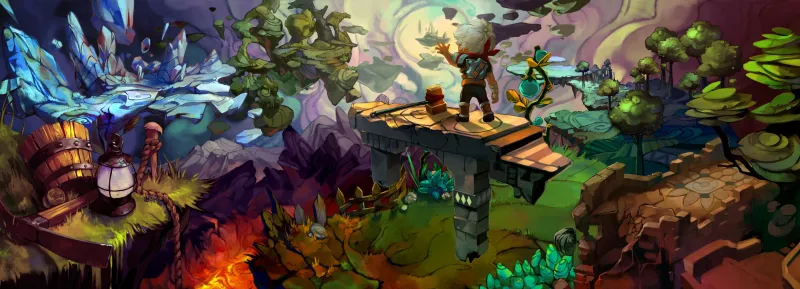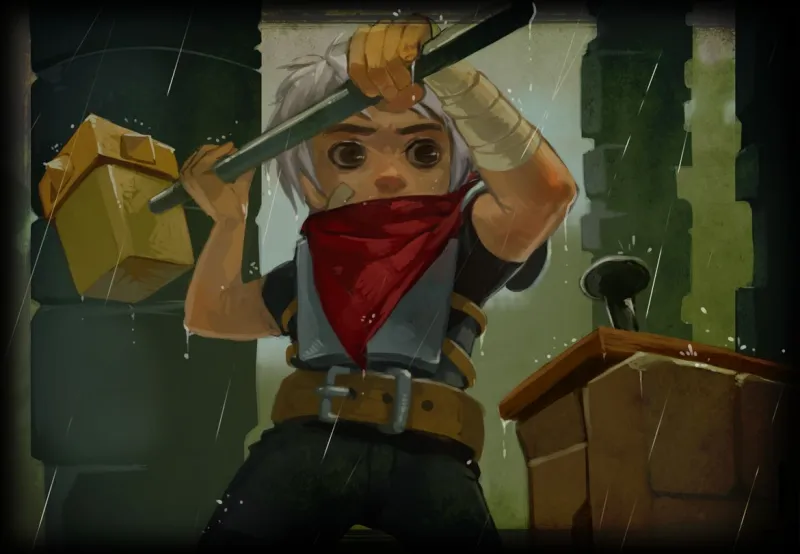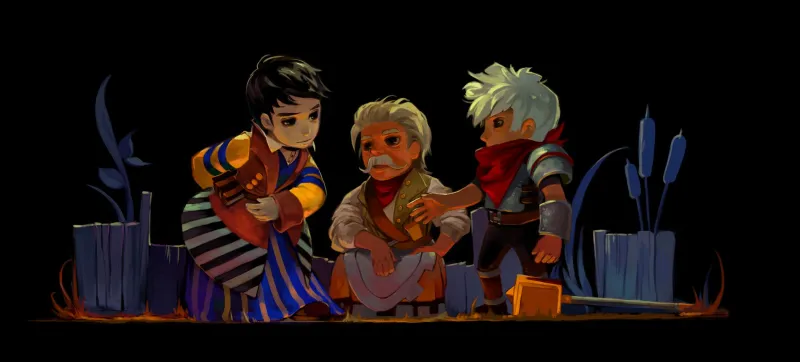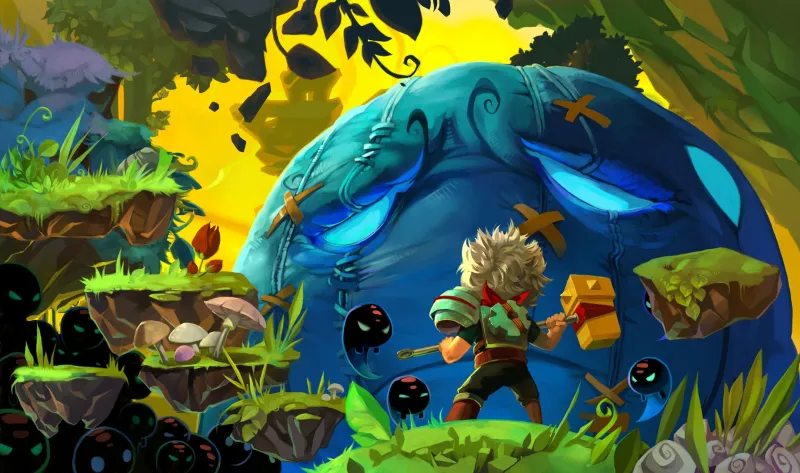
Our latest issue contains a studio profile on Supergiant Games – a small independent group of developers that keeps surprising us with inventive ways to tell meaningful stories punctuated by stellar gameplay. To celebrate the studio, we’re going to be posting the stories behind the games as told to us by the team who created them. Today, we’re starting with Supergiant’s formation to create its debut game: Bastion.
Bastion is approaching its 10-year anniversary this July, and it was the beginning of everything for Supergiant. The narrated action/RPG not only helped establish the studio, but set the standard for what we’d come to expect in terms of art, music, narrative, and gameplay – especially the way all these elements combine to create impact in Supergiant’s games. The journey to getting Bastion off the ground wasn't easy, and it took a team of talented individuals believing in themselves and each other to turn it into the success we know it as today. This is the story of how “the Kid” came to be and changed the lives of a young group of developers forever.

Assembling The Talent
Sometimes the stars align, bringing us together with the right people at the right time. When Supergiant co-founder and studio director Amir Rao took a job at Electronic Arts, it led him to meeting two key players on the Supergiant Games roster: Gavin Simon and Greg Kasavin. The trio worked together on the Command & Conquer franchise, quickly forming close friendships and learning each other’s talents and how they complement one another.
Around 2008, they all were playing games like World of Goo, Braid, Castle Crashers, and Plants vs. Zombies. “It was really inspiring,” says creative director Greg Kasavin. “These games were made by just a handful of people, but they’re really well-crafted and just more interesting in a lot of ways than what was happening then in the big triple-A space. That’s when we started thinking, ‘What would we do if we could ever do something like this?’
As ideas percolated, Rao turned to his dad for guidance. “My dad was encouraging me to start a company as well, because he felt I was young enough that if it didn’t work out, I could always try to find a job again,” he says. “And so, he let us work out of his house and we formed Supergiant Games in 2009.”
Their primary office? The living room, which is where they made the entirety of Bastion, Supergiant’s debut game. Both Rao and Simon quit their jobs at EA and got to work, officially becoming co-founders of Supergiant Games. “I didn’t really even sit down and think about or weigh the pros and cons about, ‘Is this a good idea or not?” says development director Gavin Simon. “It’s just like, ‘This is what’s going to happen and I’ve no idea how it will go.’ [Making my own game] is just what I always wanted to do.”
The duo soon recruited their third member through another friend connection. Alex Ahad, best known for his work on Skullgirls, knew Rao’s best friend from high school. When Rao said they were looking for an artist, Ahad thought of his co-worker who he happened to sit in the cubicle across from: Jen Zee
Zee, who knew she wanted to be an artist ever since seeing Tetsuya Nomura’s character art for Final Fantasy VII in a video game magazine, calls the timing “serendipitous” as she was starting to think more about where she could grow as an artist. Gaia Online was her professional gig and she was mostly focusing on environmental work. She was ready for a change of pace and more responsibility.
Before landing as Supergiant’s art director, Zee came on as a three-month contractor while she continued her day job. “The first thing she drew was the Bastion,” Rao recalls. “And it was so good that we immediately asked if she would quit her job and join us.” Zee knew it was a risk, but she was willing to take it. “We all know the statistics around the failures of startups,” Zee says. “I was young and didn’t have children. I remember calling my dad and he said, ‘You don’t really have a lot to lose right now.’”

From there, Rao’s connections only brought in more talent. He went back to Kasavin for the role of creative director. Kasavin was now at 2K Games, but was ready to quit his job there for his dream position – even if it meant asking his family for financial help for the first time since high school. “I'd never written a story for a game before … but I wanted to do it for so long,” Kasavin says. “It took Amir [Rao] and Gavin [Simon] knowing me and believing in me to fill that role on the team. But that's not a job I ever could have applied for and gotten at another studio; I just would have had nothing much to show for myself. And that's one of the catch 22s of the game industry. Every position requires having prior experience, so how do you get the prior experience until you have the job?”
Rao continued to believe in his friends’ abilities to fill the essential roles. Next, he went to his former roommate Andrew Wang, who he interned with at EA Orlando, for the role of technical director. At the time, Wang was working at Infinity Ward on the Call of Duty franchise, but he was ready to move on. “I’ve always wanted to do something with some of the more autonomy and responsibility that comes with the smaller company,” he says. “That was one of the big things that drove me in that direction from the beginning. I always knew that my stay at Infinity Ward was going to be limited and I wasn't going to be like a lifer on the Call of Duty series.”
Most of Supergiant’s team members came from Rao’s industry contacts, but the last two were his childhood friends; Darren Korb and Logan Cunningham do music and voice work, respectively. Rao met Cunningham in youth soccer, and Rao had been playing Dungeons & Dragons with Korb since elementary school. Fun fact: they still play together to this day.
Neither Korb nor Cunningham had ever worked in games, but Rao wasn’t worried about their experience. “I would say, at the time, it did not seem like a leap of faith,” Rao says. “For me, it was a no-brainer to call Darren [Korb] when I needed music and sound on a game, partially because I actually worked on some projects in college and Darren and Logan provided voiceover and music. So, when I ran into the same problem again with music and sound, I called Darren.”
There’s an old adage that you shouldn’t work with friends, but Rao says it’s part of what makes Supergiant work: “When things get hard, and they will get hard, having a friend there is really amazing, right?”

We All Got Stories Worth Tellin’
These seven original members who helped bring Bastion to life are still with the studio today, and have worked together to shape all four of its games. But back when Bastion was in development, none of them knew if Supergiant would have the opportunity to make more games. “We gave Bastion everything we had,” Kasavin says. “We were able to make this personal experience and put ourselves into our work.” In Bastion, your journey as the Kid is narrated as you attempt to rebuild a world reeling from the apocalyptic Calamity.
The team recalls having an exciting energy around doing something new and on their own – even if they knew it was a risky venture. “Everything felt like it came together so fast,” Rao says. “The game was made in less than two years, but the first year was just like, ‘What the hell are we even doing?’” adds Kasavin.
Bastion started with Rao and Simon just passing ideas back and forth and taking scans out of D&D books to use as placeholders. Rao was a huge Diablo II fan and Simon loved The Legend of Zelda series, so the pair wanted to make something that was a cross between their favorite games. “We just talked about games and games we loved,” Simon says. “We just seemed to have a lot of the same thoughts and interests about everything and it rolled forward from there.”
